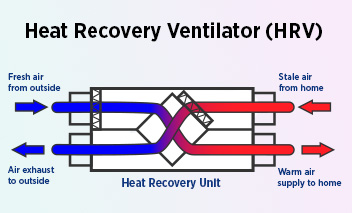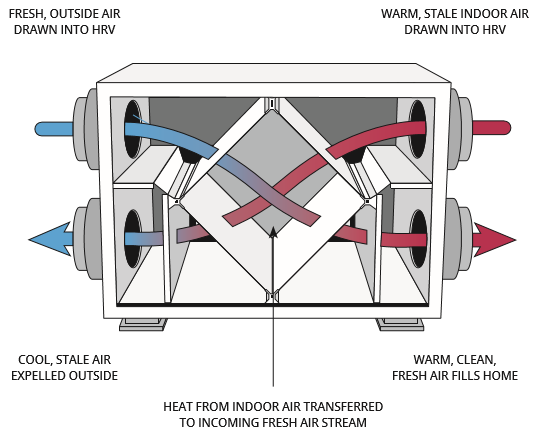The All-Inclusive Overview to the Uses of Heat Recovery Ventilation in Modern Structures
Heat Recovery Ventilation (HRV) systems represent a substantial development in building modern technology (HRV Heat Recovery Ventilation). They give an approach for trading stale indoor air with fresh outdoor air while lessening power loss. This technique not only enhances interior air quality yet also adds to energy performance in both residential and industrial buildings. Recognizing the various applications and advantages of HRV can reveal its important role in modern-day layout and sustainability initiatives. The implications of this modern technology deserve discovering even more
Recognizing Heat Recovery Ventilation Equipments

Although lots of modern-day structures focus on power efficiency, comprehending warm recovery ventilation (HRV) systems is vital for optimizing indoor air top quality and reducing energy usage. HRV systems function by moving warmth from stagnant interior air to inbound fresh air, properly maintaining comfortable interior temperature levels while minimizing power loss. These systems include a warmth exchanger, followers, and ductwork that promote the blood circulation of air. Throughout winter months, HRV devices record and recycle warm from the outbound air, while in summer, they can help cool down inbound air. By continually exchanging air, HRV systems likewise lower moisture and the focus of interior contaminants. Appropriate installation and maintenance of HRV systems are necessary for their performance and efficiency in improving overall structure efficiency and comfort.
Benefits of Heat Recovery Ventilation
Heat recovery ventilation systems supply many advantages that improve both energy efficiency and interior air high quality in modern structures. By catching and reusing power from exhaust air, these systems substantially decrease cooling and heating expenses, resulting in reduced energy consumption. They keep a constant circulation of fresh outdoor air, lessening the threat of indoor air toxins and allergens. This continuous exchange assists manage humidity degrees, avoiding mold and mildew growth and making sure a healthier living atmosphere. In addition, HRV systems add to sustainability goals by reducing overall carbon footprints. Their capacity to optimize air flow without compromising thermal convenience makes them an important addition to contemporary building style, promoting both economic and environmental benefits.
Applications of HRV in Residential Structures
As property owners significantly prioritize energy effectiveness and indoor air quality, the applications of heat healing air flow (HRV) systems in residential buildings have become extra prevalent. HRV systems are especially useful in securely secured homes, where preserving fresh air flow is vital for protecting against moisture buildup and indoor toxins. They effectively transfer warm from outward bound stale air to incoming fresh air, minimizing power prices linked with heating & cooling. In addition, HRVs can boost convenience levels by managing moisture and temperature. They are likewise versatile for various property layouts, including single-family homes and multi-unit buildings. Overall, integrating HRV systems sustains lasting living techniques while making sure a much healthier interior environment for residents.
HRV in Business and Industrial Setups
In commercial and commercial settings, the execution of heat recuperation air flow (HRV) systems has actually become significantly critical for enhancing power effectiveness and preserving air top quality. These systems effectively move warmth from exhaust air to incoming fresh air, reducing the need for additional heating or air conditioning. This not just lowers energy expenses yet likewise adds to sustainability efforts. Industries such as manufacturing, warehousing, and workplace buildings benefit substantially from HRV systems, as they aid control temperature and moisture levels, ensuring a read here comfy and productive environment. HRV systems aid in eliminating impurities and excess moisture, improving indoor air quality. As regulations around air top quality come to be stricter, the fostering of HRV technology is likely to expand, making it a critical element of modern-day commercial and commercial framework.
Future Patterns in Heat Recovery Ventilation Modern Technology

Frequently Asked Concerns
How Does Heat Recovery Ventilation Influence Indoor Air High Quality?
Heat recovery ventilation significantly enhances interior air quality by constantly exchanging stagnant interior air with fresh outdoor air while recouping energy. This procedure decreases toxins, keeps suitable moisture degrees, and assures a healthier environment for owners.
Can HRV Solutions Be Set Up in Existing Structures?
HRV systems can certainly be set up in existing structures. Retrofitting might require adjustments to ductwork and ventilation layouts, yet it substantially enhances power performance and indoor air top quality, making it a viable alternative for he said older frameworks.
What Maintenance Is Required for HRV Systems?

Are There Particular Climates Where HRV Is Much More Efficient?
Heat recovery ventilation systems are especially effective in climates with considerable temperature differences in between periods. These systems maximize power effectiveness by recuperating heat from exhaust air, making them suitable for both chilly and moderately cozy settings.
How Do HRV Systems Affect Energy Costs?
